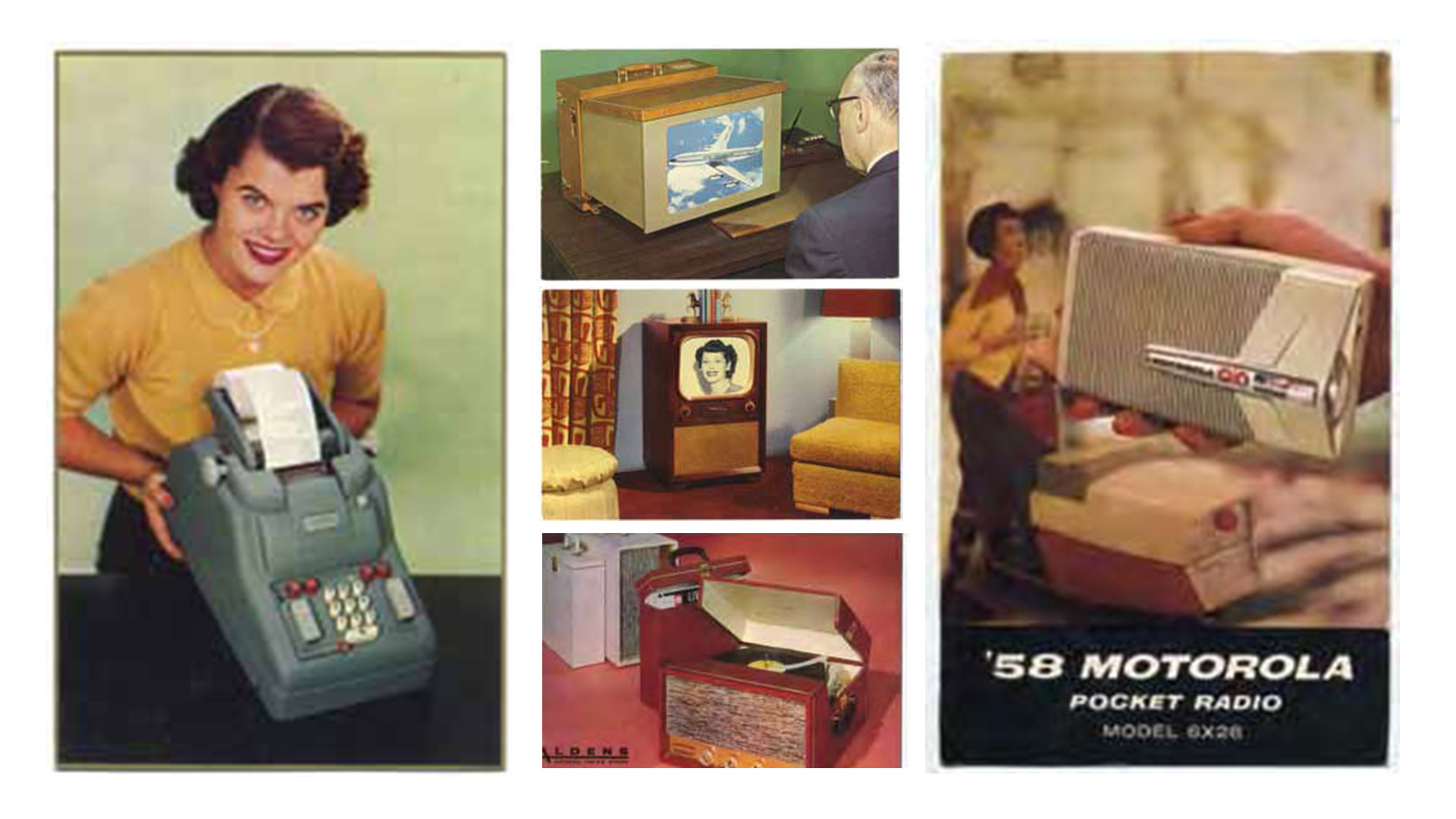
The 1950’s Version
March/April 2013. Vol. 4, No. 2
By Don Preziosi
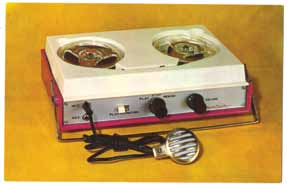
Portable Tape Recorder
Today millions of people have “smartphones” that can do many other things besides making phone calls. You can use one to take and show pictures or movies, play music and videos and games. You can use one to record music, take dictation, or, if a tiny keyboard is your thing, you can type emails and texts. And these are only the most basic uses. It can also be an alarm clock, flashlight, timer, compass, level, calculator, radio, book, map, gps device, musical instrument and, of course, a pocket computer complete with access to the Internet from anywhere. And it can probably be a few dozen other things that don’t immediately come to mind.
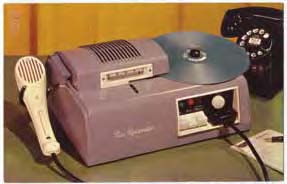
Dictating Machine
It is mind-boggling to consider that the personal technology we have taken for granted didn’t even exist two or three generations ago. When my grandfather was a boy in the late 1800s there were no cars, radios, telephones or electricity. Primitive typewriters and sewing machines were available for the affluent. And gas lamps and cast-iron stoves, which had been around for a long time, were still probably beyond the financial reach of most.
By the time I was a boy, the post-World War II era had introduced new technology, as well as major advances in existing technology. I thought it would be interesting to see how postcards depicted the cutting edge of personal technology a mere 60 years ago. These were new and exciting developments in their time, but primitive by today’s standards.
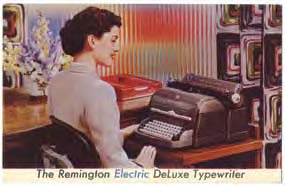
Electric Typewriter
Radios had been a fixture in most homes for several decades, but “MODERN” PERSONAL TECHNOLOGY The 1950’s Version By Don Preziosi in the 1950s the newest thing in radios was the transistor radio, which started to replace bulky vacuum-tube radios. Four Spartan “Hiker” transistor radios are shown on one postcard. Although they were portable, they needed six C batteries to operate. In 1958, Motorola introduced the pocket radio shown here, but I’m not sure whose pockets could hold this brick-sized device.
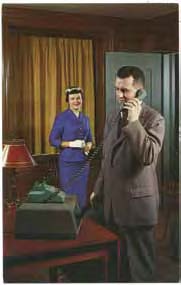
Phone Answering Machine
Television was already in some homes in the late 1940s, but these early models had massive wooden cabinets with tiny screens. The 1950s ushered in “big-screen television at a low cost” as advertised on the postcard for Kaye-Halbert TV. How big? They offered 17-inch and a 20-inch screen models. How cheap? Although the card doesn’t say, it probably cost in the neighborhood of $200 in the early ‘50s, which is at least $1,600 in today’s money. That price can now get you a flat-screen television in excess of 60 inches!
Emerson, pioneers in portable radio, introduced the “World’s only truly ‘Portable TV’” in the mid ‘50s. How portable this actually was is somewhat questionable, looking at the size and considering that this device still had vacuum tubes and a cathode-ray picture tube and not transistors. But it did have handles on each side, presumably so two people could lift it!
Telephones were really old hat by the 1950s, but two cards shown here promote two new advances in telephone technology. One postcard has a man standing and talking on a green dial phone. The huge device under the phone is a new automatic answering machine. “This automatic ‘secretary’ answers calls automatically when you’re not there.” The postcard with the happy homemaker and baby showcases the new speakerphone. “Just press a button and keep right on feeding the baby or cooking while you talk.” And it “comes in this gay yellow as well as green, beige, ivory, blue, white, pink, gray or red.”
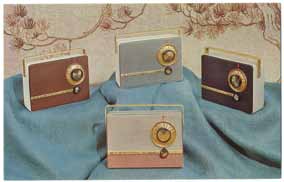
Transistor Radios
As for recording devices, shown here are two new advances in recording technology for the individual user. One is the Rex-Recorder, “the Miracle Magic Eraser Magnetic Dictating Machine,” said to “make obsolete any dictating machine using a cutting stylus… my disc is re-usable 10,000 times.” The other is an all-transistor portable tape recorder. “Take it along on vacations. Make notes in class or in business….This tiny 9 x 5 x 3-inch-high beauty weighs less than three pounds.” To put this in today’s perspective, that’s approximately the volume of 40 Apple iPhone 5’s, which, along with most smartphones, can record seemingly limitless hours.
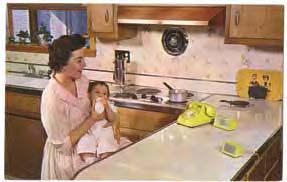
Speaker Phone
For portability in playing your own music collection, Alden offered this new “Hi-Fi Phono with Free Record Carrying Case.” I can only imagine how many hundreds of iPod Nanos or thousands of iPod Shuffles would fill the equivalent space.
Calculators were one of the earliest devices that have been miniaturized with advancing technology, but back in the 1950s you needed the device held by the winsome lady in the yellow top: the “Addo-X Plus SML,” with the “exclusive Step-O-Matic Multiplier Lever and Minus Repeat Key.” All of this bulk just to add, subtract, multiply, and divide. Today my wristwatch can do all of that and much more!

Portable Television
When it came to “word processing” in the 1950s, your only choice was the good old typewriter. Typewriters had been around since the 1860s, and even electric typewriters had been available for decades, albeit on a small scale. By the early 1950s, the electrictypewriter market was dominated by IBM and Remington; the best of these is exemplified by the Remington Electric DeLuxe Typewriter. “Electricity makes the difference! Complete electric operation allows flying fingers to flow smoothly over the keys.” In the early 1950s, a typewriter of this quality would have cost about $500 or more. That’s about $4,300 today.
Last but not least is a device designed for the traveling salesman and introduced in the late 1950s. Look for the postcard with a device that fills the desktop. It is the Salesmate, a “New Portable Audio-Visual Selling Tool. Automatic Sound Slidefilm Viewer in an Attache Case. Self-Winding, Self-Contained, Ready to Use.” Just think what a slim laptop or iPad can do today: far beyond what that 1950’s salesman could ever dream of.
Here, I have chosen postcards from the 1950s to exemplify the latest technology, but an avid collector can probably assemble an interesting group of technological advances from any decade after 1900.
For postcard collectors today, however, I do see one serious problem with smartphones. Instead of dozens of postcards showing dozens of devices, you will only need one postcard to show a smartphone!



